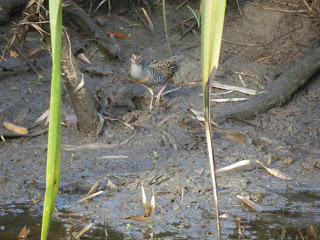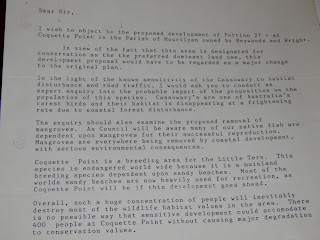The Innisfail Game Fishing Tournament is in full swing and this year over twenty boats participated. I watched them go out on Friday morning and again this morning and I watched them come in, in the afternoon. The majority of boats complied with the speed limit within the River but in every company there are hoons. In this case some of them have the biggest boats and apparently have no regard for boating rules - or the safety of other people in smaller boats enjoying a day out on the water with their families: keeping in mind it is the school holidays. One women told me she shook for three hours after one boat, and she knew the skipper/owner, passed close by, at full speed, on the wrong side of their little boat and on the wrong side of the fairway buoy creating a turbulent wake causing their boat to rock uncontrollably for some minutes.
As I watched the boats return to Innisfail I saw the same type of incidence repeated again and again. One wonders what these people are going to do with the fifteen minutes they save in getting to town.
There were very low tides this week and with all the talk about dredging the bar at the entrance to the Johnstone River a cursory examination of the river clearly shows the dynamic nature of the river system.
 A build up of sand at the northern entrance of the Johnstone River. This sand shifts to the mouth in flood events.
A build up of sand at the northern entrance of the Johnstone River. This sand shifts to the mouth in flood events.
A build up of sand on the Southern side of the entrance of the Johnstone River. This sand shifts to the mouth in strong south-easterly wind events.
A build up of sand within the Johnstone River channel. A build up of sand at the mouth of Ninds Creek. These two sand bars shift depending on which stream is in flood, the Johnstone or Ninds.
A build up of sand at the mouth of Ninds Creek. These two sand bars shift depending on which stream is in flood, the Johnstone or Ninds.
Our local history books are full of failed, costly attempts to dredge the Johnstone River. It is unfortunate that the people now advocating the dredging of the Johnstone River don't read.
This week I have been watching a Potter wasp build her nest. One can but be amazed that these creatures seem to possess an instinctive knowledge of high rise construction in the Wet Tropics.
Potter Wasp build nests containing many cells. The female lays an egg in each cell and then catches and stuns a caterpillar and inserts it into the cell. When the wasp larva hatch they feed on the caterpillar.
Before commencing construction of the cell the wasp prepares each site by seemingly hammer- drilling the surface, in this case the tree, with her proboscis and scraping the surface clean with her mandibles.
 Potter Wasp carrying balls of clay forms and builds load bearing brackets attached to the tree. At the completion of this construction she leaves the brackets to dry generally coming back the next day to continue construction.
Potter Wasp carrying balls of clay forms and builds load bearing brackets attached to the tree. At the completion of this construction she leaves the brackets to dry generally coming back the next day to continue construction.
Several hours later, or depending on the weather and sometimes not until the next day, she returns to lay her eggs.
 Its not always easy to get the caterpillar in the cell. Once, as I watched, the caterpillar was to large and she eventually pulled it out and went away to find another caterpillar. On average it took her one hour to return to the nest with a caterpillar.
Its not always easy to get the caterpillar in the cell. Once, as I watched, the caterpillar was to large and she eventually pulled it out and went away to find another caterpillar. On average it took her one hour to return to the nest with a caterpillar. Potters Wasp then reinforces the foundations of the nest and plasters over the whole nest creating a smooth finish between cell-chambers.
Potters Wasp then reinforces the foundations of the nest and plasters over the whole nest creating a smooth finish between cell-chambers.
She then returns with a ball of iridescent clay, seemingly a waterproofing compound made from her excretions and mixed with the clay. She spreads this compound over the top of the plaster coat.
Construction of Potter Wasp's nest is still under way with seven chambers completed already this week.
However lurking in the background is Cuckoo Wasp. These wasps lay eggs inside the mud nests of other wasps. How amazingly beautiful this wasp is.
 A tailed emperor butterfly enjoying the early morning sun and of all places on the mains power line.
A tailed emperor butterfly enjoying the early morning sun and of all places on the mains power line. A red-bodied Swallowtail butterfly flew into the potting shed. Before I could reach for a ladder to rescue her an Asian gecko grabbed the butterfly and ran off with her to his den.
A red-bodied Swallowtail butterfly flew into the potting shed. Before I could reach for a ladder to rescue her an Asian gecko grabbed the butterfly and ran off with her to his den.
Lots of information on cassowaries this week. Diana O rang me and said she had a cassowary with a reasonably large chick drinking from her fountain. Unfortunately no photos.
I also have a report of a cassowary with two very large brown chicks on the northern side of Ninds Creek, near the sewerage farm.
Two different people have seen 'Peggy' walking with a male cassowary. No one has managed a photo however the male could be 'Brown Cone'.
I have seen Jessie a few times this week. Here she is on Thursday searching for ripe fruit on my star apple tree.
 Snout is out and about every day wandering along the road coming from the rainforest and heading down to the mangroves. He has been avoiding Jessie.
Snout is out and about every day wandering along the road coming from the rainforest and heading down to the mangroves. He has been avoiding Jessie.
A new sub adult cassowary has wandered in. It looks about one year old and I have seen it in the forest and in the orchard a few times this week. Migration corridors are essential for juvenile cassowaries and this bird could have come from the Ninds Creek Wetlands or Etty Bay. It has very large eyes and I am calling it 'Biggles'.
The Golden Oak, Grevillea baileyana stands out in the rainforest. The underside of the leaves of this tree are coated in golden hairs that shimmer in the long rays of the setting sun.
A subtle sweet perfume issues from the rainforest where the White Cedar Melia azedarach is in flower. These exquisite little flowers will set yellow poisonous fruit that when soaked in water make an effective insecticide.
Cheers again from the rainforest of Coquette Point.
Yvonne C.






























.JPG)
.JPG)
 Powerful legs enable the monitor to climb to the top of trees.
Powerful legs enable the monitor to climb to the top of trees.







.JPG)








.JPG)
 and is looking every bit a teen.
and is looking every bit a teen. 



